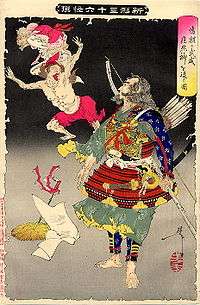Minamoto no Tametomo

Minamoto no Tametomo (源 為朝, 1139 – April 23, 1170) (also known as Chinzei Hachirō Tametomo (鎮西 八郎 為朝)) was a samurai who fought in the Hōgen Rebellion of 1156. He was the son of Minamoto no Tameyoshi, and brother to Yukiie and Yoshitomo.
Tametomo is known in the epic chronicles as a powerful archer and it is said that he once sunk an entire Taira ship with a single arrow by puncturing its hull below the waterline. It is also added in many legends that his left arm was about 4 in. longer than his right, enabling a longer draw of the arrow, and more powerful shots..[1] He fought to defend Shirakawa-den, alongside his father, against the forces of Taira no Kiyomori and Minamoto no Yoshitomo, his brother. The palace was set aflame,[2] and Tametomo was forced to flee.
After the Hōgen Rebellion, the Taira cut the sinews of Tametomo's left arm, limiting the use of his bow, and then he was banished to the island of Ōshima in the Izu Islands. In Ryūkyū, it has long been believed that he made his way down to Okinawa during his exile, and founded their kingdom by siring the first king of Chūzan, Shunten. This tale was included in Chūzan Seikan by Shō Shōken, the first history of Ryūkyū.

Tametomo eventually killed himself by slicing his abdomen, or committing seppuku. He is quite possibly the first warrior to commit seppuku in the chronicles.[1]
| Wikimedia Commons has media related to Minamoto no Tametomo. |
References
- Kerr, George H. (2000). Okinawa: the History of an Island People. (revised ed.) Boston: Tuttle Publishing.